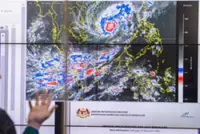High appeal: Meru Utama’s new large screen at the KLIA T1’s international arrival hall exit area offers prime advertising space for brands. — Meru Utama
PETALING JAYA: Based on Tourism Malaysia statistics, the country welcomed an impressive total of 16.4 million tourists as of August last year, achieving approximately 60% of its target of attracting 27.3 million international visitors.
It also represented a growth of nearly 30% compared to the same period in 2023.
The surge in tourist arrivals also boosted traffic at Malaysia Airports Holdings Bhd .
.
With air travel already surpassing pre-pandemic levels, the airport operator recorded just over 36 million passenger movements by the third quarter of 2024, a 10.6% year-on-year increase from 32.6 million in 2023.
With high passenger traffic, airports have become more than just entry points to get in and out of the country.
They also serve as prime spaces for advertisers and marketers to engage a captive, high-quality audience.
The appeal is undoubtedly clear: travellers who are considered affluent and influential that spend extended time in airports, making them an ideal demographic for marketing.
For brands, this provides not only an advantageous environment but also a prime audience to target.
This is an area that Meru Utama knows intimately well.
As a pioneer in the airport advertising industry, the company has plied its expertise in the trade for nearly 40 years.
“Currently, we are managing the advertising mediums in KLIA (Kuala Lumpur International Airport) Terminal 1 (T1), KLIA T2 and Senai International Airport (Johor),” Meru Utama general manager Herman Lim told StarBiz.
The firm also works closely with partners for other airports and transit platforms like Kota Kinabalu International Airport, Kuching, Penang, Langkawi and Subang.
Meru Utama also inked an agreement with Express Rail Link Sdn Bhd (ERL) in August to become the ERL’s media concessionaire. Under the three-year contract, Meru Utama will manage and operate ERL’s advertising assets across all stations, as well as all KLIA Ekspres and KLIA Transit trains.
It will also invest in and instal new state-of-the-art digital assets at the stations.
According to Lim, airport advertising is vastly different from other media forms.
“It’s an environment filled with holidaymakers and business travellers who have long dwell times.
“These captive audiences are receptive to advertisements and have strong purchasing power,” he noted.
He opined that airport advertising elevates a brand as it’s seen alongside other top brands and luxury products.
In 2024, KLIA served over 50 million passengers, making it an ideal platform for cost-effective marketing campaigns targeting middle- to high-income groups.
Industries like telecommunications, finance and tourism have already recognised the benefits of airport advertising and recently, other sectors have also taken notice of the benefits of high volumes of captive audiences.
To cater to the demand, Meru Utama offers a wide variety of advertising mediums at airports including LED screens and lightboxes.
However, Lim said jet bridges and the Aerotrain are the most sought-after assets.
“Our recent partnership with Trip.com, which dominated the jet bridges in KLIA T1 and T2, certainly raised eyebrows,” he said.
HSBC also captured travellers’ attention as it “painted” KLIA T1 Satellite building’s walkalators red, and hang giant banners as well as digital screens in the gate rooms.
“With the new Aerotrain soon to be operational, we already have several interested clients wanting their brands on it.”
Beyond screens and banners, airport advertising offers innovative, creative space for brands. Lim revealed that clients can wrap trains, buses, pillars, trolleys, lifts and baggage carousels.
One past creative campaign saw a jet bridge wrapped in a jungle theme, with speakers playing serene rainforest sounds, as part of a tourism campaign.
“We’ve also had activation spaces where clients showcased their product, offered interactive games and provided product sampling, which delivered not just high engagement but also provided a unique brand experience,” he said.
Looking ahead, Meru Utama plans to continue expanding its airport presence.
On Jan 1, 2025, the company unveiled a new large digital screen at KLIA T2 called the “T2 Digital Dream”.
Measuring 14ft high and 81ft wide, the screen is located in the international arrival hall exit area, offering prime advertising space for brands.
“Our assets in the airports are segmented to cater to clients that want to target different audiences from domestic to International travellers, and arriving to departing passengers, which allow clients to have different messages displayed in different areas,” he explained.
To that effect, Lim believes with the evolution of technology, artificial intelligence (AI) will also play a role in advertising.
“I foresee AI advertisements coming to the forefront to cater to individual needs and wants.
“Similar to programmatic online and mobile advertising, the future might have LED screens displaying products and recommendations to passengers browsing similar items on their smartphones within proximity of the screens,” he added.





